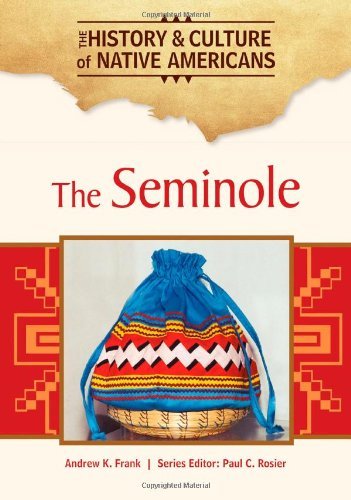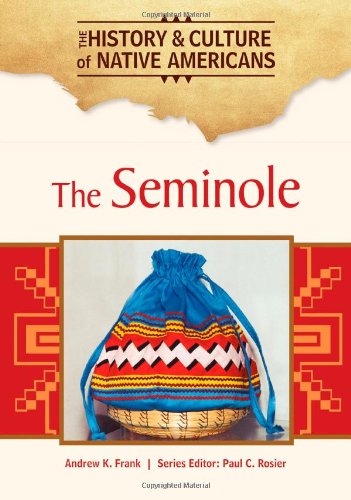-
The Trail of Tears: Removal in the South
John P Bowes, Associate Professor of History Paul C Rosier
Library Binding (Chelsea House Publications, June 1, 2007)In 1830, Congress passed the Indian Removal Act, which authorized President Andrew Jackson to move eastern Indian tribes west of the Mississippi River to Indian Territory. Often solely associated with the Cherokee, the Trail of Tears more accurately describes the forced removal of the Five Civilized Tribes, which in addition to the Cherokee includes the Chickasaw, Choctaw, Creek, and Seminole. This book is an insightful and honest exploration of this dark chapter in Native American history.
-
The Hopi
Barry Pritzker, Associate Professor of History Paul C Rosier
Library Binding (Chelsea House Publications, June 1, 2011)The Hopi provides insight into a group of people who live in one of the most remote parts of what is now the United States. This book explores the history of the Hopi people as well as how they live today.
-
The Seminole
Andrew K Frank, Associate Professor of History Paul C Rosier
eBook (Chelsea House Publications, Nov. 1, 2010)The Florida Seminole are widely known as the only unconquered tribe in the United States. They began as an offshoot of Creek and other Indians who survived the diseases and warfare that took so many lives in the 16th century. In later years, they fought three wars with the United States and then faced a series of other crises. They saw their homelands taken from them and were forced to migrate hundreds of miles south to the Everglades. After decades of struggling to survive and efforts at assimilation taking a toll the path to success, the Seminole have recently undergone a dramatic transformation. The tribe now runs a billion dollar business and leads the national fight for tribal sovereignty and gaming rights. The rise of the politically and economically savvy Seminole has coincided with a renaissance in Seminole culture. The Seminole explores this unique transformation.
-
The Lakota Sioux
Frank Rzeczkowski, Associate Professor of History Paul C Rosier
Library Binding (Chelsea House Publications, May 1, 2011)The history of the Lakota people is often understood solely through conflict and legendary figures such as Sitting Bull and Crazy Horse. This informative book documents the Lakota Sioux's ongoing struggle to remain a distinct people and culture in a rapidly changing world.
-
The Lakota Sioux
Frank Rzeczkowski, Associate Professor of History Paul C Rosier
Library Binding (Chelsea House Publications, May 1, 2011)The history of the Lakota people is often understood solely through conflict and legendary figures such as Sitting Bull and Crazy Horse. This informative book documents the Lakota Sioux's ongoing struggle to remain a distinct people and culture in a rapidly changing world.
-
The Seminole
Andrew K Frank, Associate Professor of History Paul C Rosier
Library Binding (Chelsea House Publications, Nov. 1, 2010)The Florida Seminole are widely known as the only unconquered tribe in the United States. They began as an offshoot of Creek and other Indians who survived the diseases and warfare that took so many lives in the 16th century. In later years, they fought three wars with the United States and then faced a series of other crises. They saw their homelands taken from them and were forced to migrate hundreds of miles south to the Everglades. After decades of struggling to survive and efforts at assimilation taking a toll the path to success, the Seminole have recently undergone a dramatic transformation. The tribe now runs a billion dollar business and leads the national fight for tribal sovereignty and gaming rights. The rise of the politically and economically savvy Seminole has coincided with a renaissance in Seminole culture. The Seminole explores this unique transformation.
-
The Comanche
Theresa Jensen Lacey, Associate Professor of History Paul C Rosier
Library Binding (Chelsea House Publications, Oct. 1, 2010)The Comanche are a fascinating people with an intriguing history. Settling on the South Plains of the United States on what would become known as the Comancheria, the Comanche trace their tribal origins to a Bering Strait migration and a union with the Shoshone. Earning a reputation as the fiercest of fighters, the greatest of horse riders, and the "Lords of the Plains," these people ruled the Comancheria for a 150-year period, striking fear into white settlers, U.S. soldiers, and other Native Americans alike. Before turning themselves in to the reservation, their lives were nomadic and free, moving with the great buffalo herds. The Comanche brings readers a wealth of history, tradition, and myths of these vibrant people and culminates with information about the Comanche people in present-day society.
-
Little Bighorn: Winning the Battle, Losing the War
Michael L Lawson, Associate Professor of History Paul C Rosier
Library Binding (Chelsea House Publications, July 1, 2007)On June 25, 1876, the US Army suffered its worst defeat to the Native Americans at the Little Bighorn River in Montana. This book traces the events that led to this historic confrontation.
-
The Cheyenne
Samuel Willard Crompton, Associate Professor of History Paul C Rosier
Library Binding (Chelsea House Pub, May 1, 2011)Thanks to cowboy-and-Indian movies of the 1950s and 1960s, the Cheyenne are among the best known of all Indian tribes. The moviegoer can readily picture the fast-moving Cheyenne, mounted on handsome horses, battling the U.S. Cavalry. While that image is indeed part of the story, the Cheyenne tribe is about much more than 19th-century warfare. The Cheyenne have persevered through strange and difficult times to emerge as one of the best adapted of all Great Plains peoples. They fought the U.S. Army with considerable success, but after the eventual defeat, the Cheyenne changed to a life of cattle herding and Plains farming, with tractors and harvesters as much a part of their lives as horses and war bonnets. The Cheyenne covers the storied history of this highly recognizable tribe, from its origins to its interactions with Europeans and later the U.S. government, to its place in the United States today.
-
The Noisy Farm
Associate Professor of History Marni McGee
Hardcover (Bloomsbury Publishing PLC, March 15, 2004)Enjoy a day with the farmer as he goes about his jobs on the farm. And there is so much to do, from feeding the animals, planting the crops, mending the fence and making his own breakfast to finally tucking himself safely into bed. Throughout the entire day the jolly farmer is accompanied by the joyful and tremendous noises of the farm but in his sleep the quiet farmer is not so quiet after all. This is a delightful book for all farm-interested, animal-obsessed children - who like making a lot of noise!
-
The Best Christmas Ever!
Associate Professor of History Marni McGee
Paperback (Little Tiger Press Group, Sept. 1, 2011)Christmas is only a day away, and Millicent Mouse has scrubbed and dusted and baked, until everything is perfect! But when her plans go topsy-turvy will she have her perfect Christmas?
-
Bumble - The Little Bear with Big Ideas
Associate Professor of History Marni McGee
Paperback (Little Tiger Press Group, Feb. 1, 2011)Meet Bumble, the little bear with the big ideas - and a very big heart. Grandma is ill, so Bumble decides to help out. It will be a lovely surprise when she wakes!